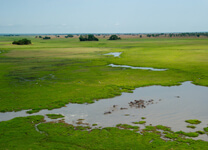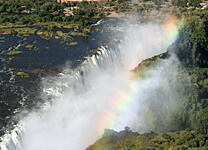
Bilimungwe Bushcamp
- South Luangwa National Park, ZambiaOverlooking 3 waterholes with many herds of resident elephant, Bilimungwe Bushcamp is a hidden gem under huge mahogany trees.

Zambia is situated mainly on a vast central plateau, and boasts the Zambezi, Kafue and Luangwa rivers - as well as one of the largest waterfalls in the world, the Victoria Falls, which it shares with neighbouring Zimbabwe. Most of the country has a mild, pleasant climate, while the river valleys are hotter and more humid; the extreme north becomes tropical on the shores of Lake Tanganyika, one of Zambia's ten large lakes. While Lusaka is the country's capital, Livingstone, just ten kilometres from the Falls, is more well known to adventurous travellers.
Things to look forward to in Zambia:The 2.25-million-hectare Kafue National Park and surrounding game management areas in central Zambia make up the largest conservation area in the country.

One of the Seven Natural Wonders of the World, the Victoria Falls forms a dramatic disruption in the mighty Zambezi River.

Video supplied by The Bushcamp Company
Zambia offers impressive diversity as well as large concentrations and numbers of wildlife, and some of the wildest and most remote game areas in Africa. Kafue National Park’s Busanga Plains are famous for lion prides while plains game such as puku, red lechwe, Lichtenstein’s hartebeest, oribi and buffalo can be seen. Cheetah and wild dog are present, and a treat is the resident herd of rare roan antelope.
The Zambezi River is home to hippo, crocodile and elephant, as well as incredible birdlife. Mosi-oa-Tunya hosts species such as buffalo, giraffe, zebra, wildebeest and white rhino.
Birdlife in Zambia is prolific, with over 750 bird species found here, including many specials; the north of the country is the southernmost extreme of the bizarre-looking African Shoebill's range.
The two areas in which we are present in Zambia generally adhere to the same seasons, with one difference: Our camps in the Busanga Plains, Kafue National Park, are only operational in the dry season – from June to the end of October. Below are a few helpful highlights of each time of year in Victoria Falls and Busanga Plains respectively.
The summer months are a time of great light for photography, beautiful greenery and abundance of migrant birds like cuckoos, rollers, kingfishers, shorebirds and bee-eaters. Wildlife in Mosi-oa-Tunya National Park is abundant, particularly in the early mornings, with elephant and buffalo coming down to drink at the river. The Zambezi River water levels also rise during this time, making the thundering Victoria Falls a spectacular sight of sheer magnificence and power, with an immense cloud of spray.
The camps are closed during this period.
While there is little rain, the Zambezi River levels are still high, meaning that the flow over the Victoria Falls is spectacular. At the beginning of this time, the high spray can obscure views of the Falls, with visitors generally getting pretty wet! The peak is probably June/July.
By contrast, in November, the water volumes flowing over the Falls are far less (so that viewing is best from the Zimbabwean side) and the dry surrounding environment means that wildlife is attracted to the Zambezi River making for good sightings during boating activities.
Our camps typically open in June, when the level of water on the Busanga Plains is still high. If the rains have been good, boating is still possible as an exciting activity with spectacular birding on the Plains at this time. Lechwe and puku are very concentrated in numbers, and lion prides are typically very focused close to the Busanga camps as a result of limited dry land, with even occasional sightings of swimming lions and chases through water!
August to October are the peak of the dry season and thus the best time for game viewing along the Zambezi River with plenty of wildlife attracted to the southern bank and seen from boats. Low water levels provide an ideal breeding habitat for bird specials like rock pratincoles, African skimmers and white-fronted bee-eaters; meanwhile, summer migrants are starting to arrive and breed. From September, the water volume of the Victoria Falls can be quite low and so the Falls are best seen from the Zimbabwean side.
Busanga Plains, Kafue National ParkThis is the peak game-viewing season here. As the plains have dried up almost completely, wildlife has settled here, safari vehicles can access a wider area and hot air ballooning is possible. Zebra and wildebeest form large aggregations and there’s an excellent chance of seeing Lichtenstein’s hartebeest. This is the best time for cheetah and wild dog sightings. Lions are abundant (namely the Busanga, Papyrus and Tree Line Prides), and this time of year is ideal to try for the unusual sight of lions climbing fig trees!